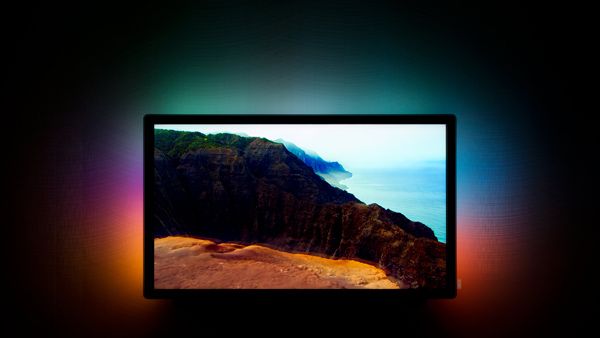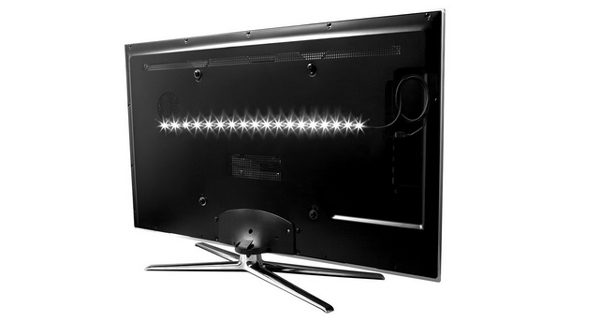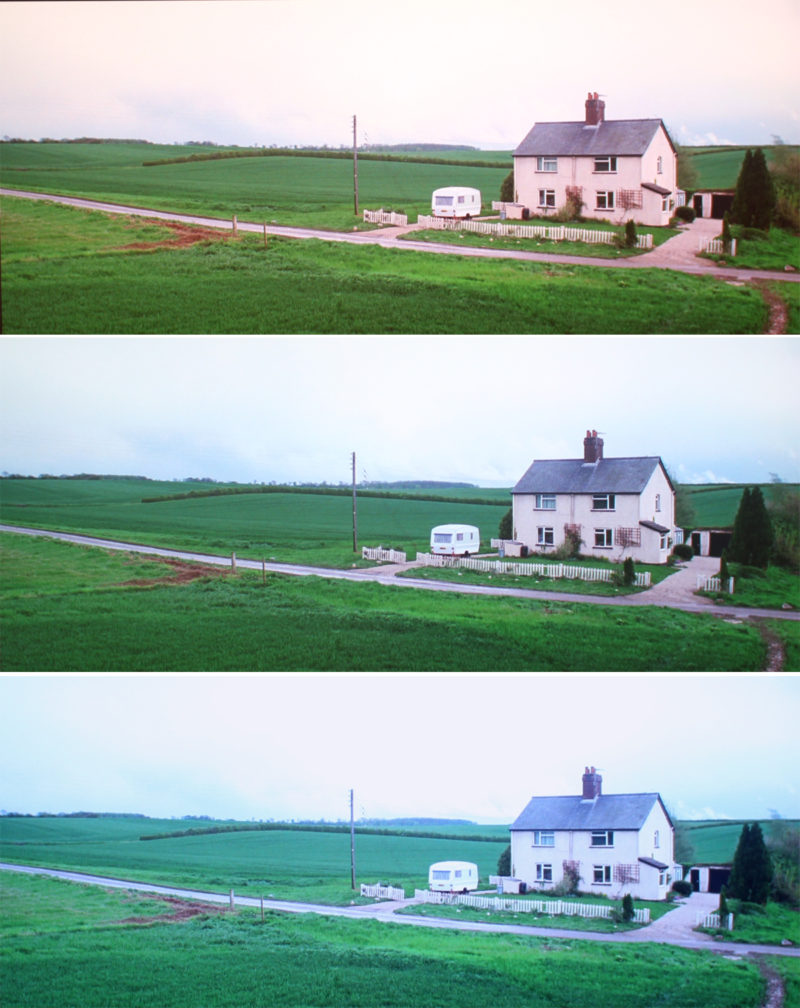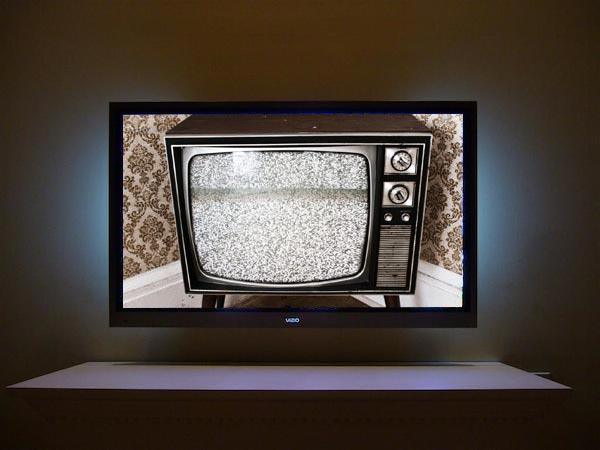If you’re anything like me then you’ve probably not heard of bias lighting before. The term itself has an air of industrial precision about it, like something you’d find in a submarine, or Germany.
However, if you remember the Philips Ambilight TV adverts from yesteryear then you absolutely know what bias lighting looks like, even if you don’t know the name per se.
If you don’t remember, here’s a little reminder…

Look familiar? At the time the cynic in me took one look at the coloured lights undulating on the wall behind the display and wrote the whole thing off as a gaudy marketing gimmick, or rather a way of bolting an additional £300 onto an already exorbitant price tag.
Well, it seems there is actually a good deal of science behind this innovation and it’s nowhere near as expensive to implement as you might think.
Before we delve into all that though we’ll need to actually look at the mechanics of the human eye, and why they’re important.
Watching TV on a dark background can seriously strain your eyes
Most of the light fittings you’ll find in a living room aren’t really conducive to an immersive viewing experience. They’re generally positioned either in the ceiling or around head height and, crucially, always in front of the television screen.
This will invariably cast glare onto the viewing area and pretty much wreck your ability to see what’s going on. Contrast and colour become nothing more than a myth and the next few hours of your life are spent chasing intermittent flashes of light across the screen; neck cocked at a grotesquely unnatural angle, in the hope that at some point you’ll be able to marry the sound – mocking you in its clarity – with a picture.
Of course, very few people will actually put up with this state of affairs for any length of time which is why most of us generally opt to either dim the lights or do away with them all together before settling down for a film or Sunday evening TV binge. However, this act in itself poses its own set of unique problems.
You see, your eyes are breathtakingly clever. They’re constantly adjusting for changes in light and colour that are at times so minute that they remain largely imperceptible to us. This is perfectly natural and your eyes are perfectly capable of dealing with these smaller changes.
However, sitting in a darkened room and gazing intently at an artificially backlit screen for hours on end is anything but natural and so your eyes, naturally, have a much harder time trying to adjust.
This can cause some serious problems because of the way in which your eyes work, which involves absorbing light from across your entire field of vision and then reacting accordingly. Your pupil will normally dilate or contract based on how much cumulative light it receives. It doesn’t matter whether you’re staring at a light bulb, car headlights or a sunset; your eyes evaluate how much light is collectively streaming in through them and adjust accordingly.
This is why emerging from a darkened cinema on a bright summer’s day can be relatively painful for a couple of seconds as your pupils, which have been blown up to the size of dinner plates for the past 2 hours to adjust for the dark environment, pretty much slam shut in an attempt to prevent a sea of sunlight flooding in and incinerating your retinas.
This behaviour, while helpful, can cause serious problems under the circumstances discussed above. If your field of vision stopped at the edges of the screen then any potential issues would be all but eradicated. Your eyes would simply recognise that you were looking at a bright object and make the necessary adjustments.
However, because (in a darkened room) this bright screen is framed by the darker area that surrounds both it and you, your eyes also have to factor in these darker areas and subsequently struggle to cope with the massive imbalance between light and dark.
This creates a situation where your eyes are working overtime to account for an unusual set of circumstances that evolution hasn’t quite prepared you for, resulting in fatigue, headaches, and impaired vision.
What is bias lighting and how does it help?
Put simply, bias lighting is any light source positioned behind the viewing surface. It can take many forms, but the benefits of doing so are extensive.
Firstly, it raises the level of ambient light in your field of vision. Your eyes will still receive the same amount of light from the screen, but the additional light surrounding it addresses the imbalance between light and dark that existed before. This alleviates your eyes’ workload and wards off the headaches, dry eyes, ocular migraines and visionary problems that can accompany this situation.
Secondly, the introduction of extra light into your field of vision massively improves the reproduction of blacks and greys on your screen, or rather; it creates an environment in which your eyes can be tricked into perceiving that this is the case.
Confused? Not to worry – I have just the thing…

Believe it or not, the grey bar in the centre of the image above is the same colour throughout. What this illustrates, aside from how easy it is to trick one’s eyes, is that contrast is everything. Notice how the grey bar appears washed out on the left-hand side but becomes richer, darker and more defined as you head towards the right-hand side with the comparatively lighter background.
Placing bias lighting behind your television will recreate this illusion. Blacks and darker areas will appear, well, darker, because of the additional ambient light. This, in turn, improves your perception of contrast and further enriches your viewing experience.
This same effect can be achieved by cranking up the brightness and colour settings on your TV. Some of you reading this may have adopted this solution already and, though its effectiveness cannot be questioned, it does place an inordinate amount of strain on your TV’s backlight. Introducing bias lighting will allow you to return your TV to its factory settings and thereby extend its operational lifetime without sacrificing picture quality.
What can I use as a bias light?
So, you’re finally sold on the idea of bias lighting but don’t really know where to start in terms of equipment, or how to install it. Well, try not to worry, for we have compiled a brief list of effective and – more importantly – COST-effective methods for setting up the perfect bias lighting system in your home.
Firstly, let’s talk about LED strip lights. Their versatile design lends them to an array of applications – bias lighting included. Placing a single strip across the back of your television will create a more subtle, diffused effect that emanates from the centre of the TV, while you can also place a strip on each of the four edges for a more aggressive effect.

LED link lights are also a great idea, particularly if you’re looking to go for a more diffused effect. Simply place one on the rear of the television and light will appear to emanate gently from the centre of the screen.
Colour temperature and why it’s important
Before you choose an option though it’s important to consider colour temperature.
It’s always important to pay attention to the colour temperature of your lighting, but it is extra relevant in this instance because of how your perception of colour can change depending on the context. Much like the illusion above, the colours that surround the viewing area can greatly impact your perception of those inside it.
It’s therefore wise to opt for a light source of similar colour temperature to that which is adopted both by the manufacturer of your television and the makers of your content – that magic number, by the way, is 6500 kelvin.
6500k is the colour temperature at which the light bulbs in your television will be calibrated. The footage playing on it will have been corrected or shot in such a way to ensure that the white reference point matches (you guessed it) 6500k, while the studios in which everything was edited will also have been kitted out with 6500k bias lighting.
This is all done to ensure that consistency is preserved right across the production process; from shooting right through to delivery via your TV.

Using a 6500k (or daylight coloured) light source will ensure that the content on your screen is displayed exactly as the director and editor intended it. Using bias lighting with a distinctly warmer bias will give your content a warmer, orangey hue, while lighting that is too cool may make everything appear slightly blue.
The image above illustrates this point perfectly. The image in the middle has a white reference point of 6500k, while those above and below it have colour temperatures of 5000k and 9000k, respectively.
Of course, if you’re only looking to alleviate eyestrain then you might not need to pay as much attention to the colour of your bias lighting. The addition of any sort of extra ambient light will solve this problem. However, if you’re looking to attain the purest viewing experience possible, with colour and contrast rendered absolutely perfectly, then we’d recommend daylight coloured lighting every time.
With this in mind, we’d generally recommend going for the coolest colour option available. Daylight is best of course, with a colour temperature of around 6500k. However, cool white strips and LED link lights will also produce the cooler light necessary for accurate colour rendering.
What we’d certainly advise against is warm white light (which is similar to that produced by traditional incandescent light bulbs) or coloured light, which can wreak all sorts of havoc with your ability to perceive the colour on screen properly.
Maybe buying that Ambilight TV was a mistake after all…





Excellent article and more to the point written for the technophobes!